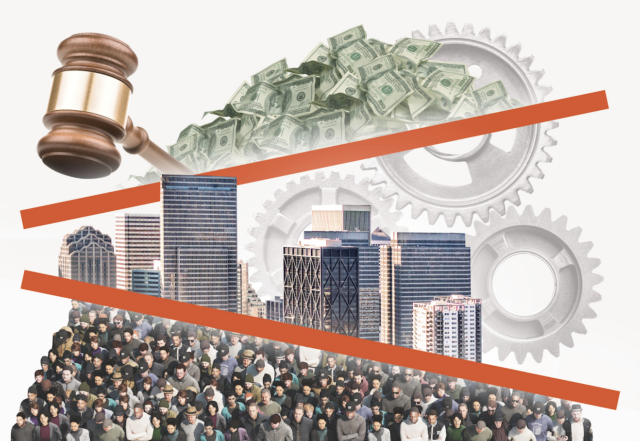
Thought Pieces / Jan 28, 2025
Framing Childcare as a Rigged System

The notion that “the system is rigged” is a powerful mindset shaping the way that most Americans think about a range of social issues. Research from the FrameWorks Institute’s Culture Change Project has found that more than 70 percent of Americans endorse the idea that the system is rigged by an elite few at the expense of “regular” people. This mindset encapsulates the idea that certain systems and structures in American society are designed to unfairly benefit a select group while disadvantaging others.
While this mindset is widely prevalent in American thinking, it is also fuzzy, leaving gaps that can be exploited in different ways. For example, it can serve as a rallying cry for progressive systems change aimed at promoting equity and justice—or it can be weaponized to fuel racist and xenophobic agendas.
The dual potential of the System is Rigged mindset is evident in contemporary discourse. For example, progressive advocates might highlight systemic inequities in housing, healthcare, or education to push for reforms, while others might exploit the rhetoric to falsely claim that immigrants are “rigging” the labor market or social services system to their advantage. Understanding and harnessing this mindset requires addressing its fuziness—clarifying what system is rigged, by whom, to what effect, and how to unrig it—to steer it toward progressive social change.
Childcare is a striking example of a rigged system.
It is a critical, yet chronically undervalued and underfunded component of society. The current childcare system does not ensure equitable access to quality care for all children and families, nor does it provide fair compensation and working conditions for childcare workers. Most families cannot afford the high costs of childcare, and those costs are insufficient to guarantee a living wage for early childhood educators. This disconnection underscores a rigged dynamic in which families and workers are caught in an unsustainable cycle, while policymakers largely fail to address systemic shortcomings.
Progressive advocates can leverage the System is Rigged mindset to inspire support for transformative change. FrameWorks research emphasizes the importance of clearly explaining how systems operate and where they fall short. To make the narrative more compelling and complete, consider filling in the story in the following ways:
What system is rigged?
The childcare system is designed in a way that fails to meet the needs of families, children, and workers. High-quality childcare is inaccessible to many families due to exorbitant costs, and the burden falls disproportionately on women—both as parents and as workers in the childcare sector. Early childhood educators, who are predominantly women of color, are grossly underpaid and subjected to long hours and difficult working conditions. This lack of systemic support reflects broader societal inequities and limiting opportunities for both children and caregivers.
How is it being rigged?
The “rigging” of the childcare system can be attributed to decades of political inaction and inadequate public investment. Policymakers have historically neglected to prioritize childcare as a public good, leaving families and workers to bear the brunt of the costs. This neglect disproportionately affects marginalized communities, exacerbating racial and economic disparities.
To what effect?
The consequences of this rigged system are far-reaching. Children from underserved communities miss out on critical early development opportunities. Families are forced to make difficult choices, such as sacrificing careers or other necessities to afford childcare. Meanwhile, early childhood educators are undervalued and overworked, leading to high turnover rates and an unstable workforce. These inequities reinforce societal divisions and undermine the potential for a more just and equitable society.
How do we unrig the system?
Addressing the rigged nature of childcare requires a bold reimagining of the system as a publicly funded, equitable, and sustainable structure.
FrameWorks research also suggests other framing strategies advocates might take into consideration as they talk about childcare as a rigged system.
- Lead with a Compelling Vision: Articulate a vision of a childcare system where every family has access to affordable, high-quality care and where educators are respected and fairly compensated. This vision can inspire hope and build momentum for change.
- Create Space for Discussions About Racial Inequity: Acknowledge the racial and economic disparities embedded in the current system. Highlight how systemic racism impacts families of color and the predominantly women-of-color workforce, and emphasize the need for policies that promote equity.
- Focus on Early Development and the Brain: Emphasize the importance of early childhood experiences for brain development and long-term outcomes. Framing childcare as an investment in the future of society can resonate across political and ideological divides.
- Promote Collective Solutions: Demonstrate that systemic change is possible through collective action. Showcase examples of successful publicly funded childcare models and emphasize the benefits of shared responsibility in creating a fairer system.
By filling in the gaps of the System is Rigged mindset with concrete examples, clear explanations, and actionable solutions, advocates can channel its power toward building a fair, just, and equitable childcare system. This approach not only unpacks the complexities of a rigged system but also empowers communities to envision and work toward a better future.
For more information on how to talk about rigged systems, check out:
Issues: Child Development, Education, Families
